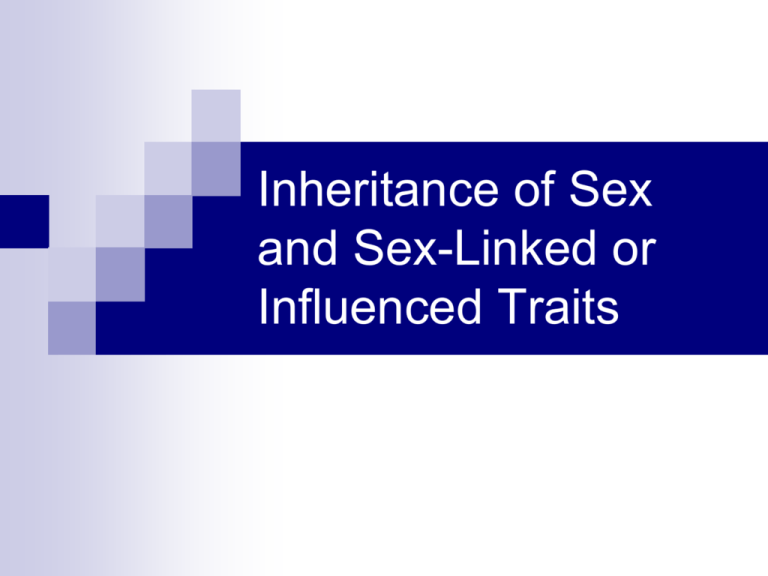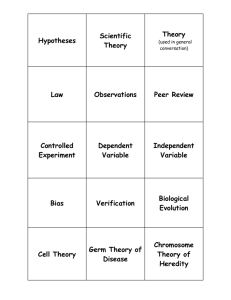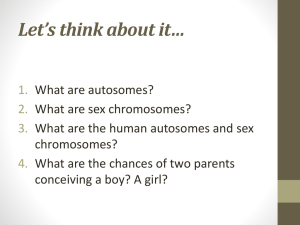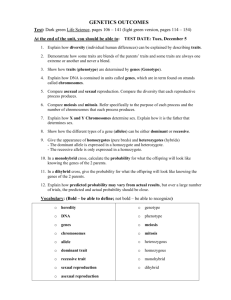Inheritance of Sex and Sex-Linked or Influenced Traits
advertisement

Inheritance of Sex and Sex-Linked or Influenced Traits Sex Determination Sex chromosomes determined at fertilization _____ = female _____= male Sperm determines sex Females only make ___ eggs Males make ________ sperm Can We Influence the Sex? Historical Views Thought __________ determined the sex Thought the __________________ determined the sex Some Current Theories Chemical environment of female reproductive tract Timing of sex around _______________ Comparing the Chromosomes X chromosome ____________ genes Y chromosome ___________ genes Sex-determining region of the Y (_______ gene)- gene that codes for maleness Looking Closer at the Y Very small Tips are called pseudoautosomal regions Genes similar to genes on X Can recombine with X Middle section called male-specific region (MSY) Genes essential to fertility including SRY Genes nearly identical to X Amplicons- regions of palindromes Sex Development During fifth week of development Unspecified gonads form Two duct systems form Mullerian ducts- will develop into ________ structures Wolffian ducts- will develop into ________ structures During sixth week In males- SRY gene is activated In females- no SRY gene, other genes control development What does SRY do? Codes for a __________________that activates other genes controlling male development Indifferent gonads develop into testes Secrete anti-Mullerian hormones which causes these ducts to degenerate Secrete testosterone to stimulate some internal male structures to develop Some testosterone is converted to dihydrotestosterone (DHT) which cause external and some internal male structures to develop When Things Go Wrong Androgen insensitivity XY chromosomes Testosterone is produced but receptors are absent or faulty Phenotypic, but infertile, she Male pseudohermaphroditism XY chromosome Block in testosterone production Phenotypic she at birth At puberty, other sources of testosterone are produced and male characteristics start to develop Severe Combined Immune Deficiency Syndrome Sex-Linked Traits Y-linked Traits Rare because so few genes None currently well understood besides infertility Trait would be passed from ______________ X-linked Traits Can be recessive or dominant Recessive X-Linked Traits Expression Females______________________ Males- only need one copy (_____________) Inheritance Fathers pass mutated allele to all ___________ Mothers pass mutated allele to _______________ Dominant X-Linked Trait Both females and males only need one copy Females are usually less severely affected because one X is still ok Some disorders are _________ in males Sex-Linked Punnett Squares Same as other Punnett squares Mom on one side, Dad on other Need to write it like this: ___________ Y does not have a letter Calico Cats X Inactivation Occurs during early embryonic development Each cell inactivated about ______ of one of the X chromosomes Which X is chosen at random All cells in that lineage will have the same inactivation Barr Bodies X chromosome is inactivated by attaching __________(epigenetics) Inactive X chromosomes absorb more stain creating a Barr body in the cell Males do not have a Barr body Consequences of Inactivation In _____________ disorders Females can have patches of tissue that express mutant allele Most of the time enough parts are normal to not have the effects of the disorder Manifesting heterozygote- female who expresses mild form of disorder because of inactivation In _____________ disorders Females have normal and abnormal tissues throughout body Sex-Limited Traits Traits can be inherited on autosomal or sex chromosome Trait only affects __________________ For example Beard growth Pregnancy- Preeclampsia Milk production Sex-Influenced Trait May be inherited on autosomal or sex chromosome Sex of individual __________________ May be dominant in one and recessive in the other Genomic Imprinting Another form of epigenetics Gene from specific parent is silenced in each generation using attached methyl groups Methyl group are removed during meiosis and replaced once new embryo forms Most seem to control early embryonic development











